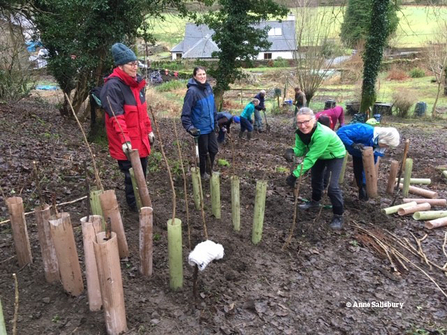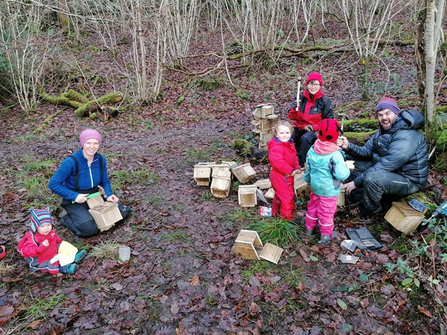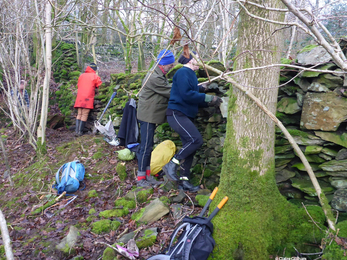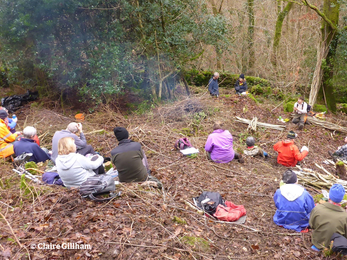We are well on the way to having enough to cover the link land nicely. The collection of different species is coming on nicely too; we now have oak, hazel, rowan, dog rose, blackthorn, hawthorn, bird cherry, wild cherry, alder, crab apple, small leaved lime, guelder rose, downy birch, silver birch, goat willow and spindle all successfully growing.
Cold conservation days and coppice coup chatter - January 2020 Blog
Jane Wilson

Tree Planting - Anne Salisbury
As you can see from the picture, we are still busily protecting our trees with tubes from the resident deer population. Our latest big donation of tubes kindly came from a local resident who had extras left from his own planting project. The plan for the finally planting site at Staveley Woodlands Nature Reserve is to avoid the use of tubes with clever planting to deter the deer; then these tubes can go on to another project that may need them.
Coppicing in Dorothy Farrer’s is nearing completion for this section, and will be ready for spring to come and rouse the new growth. We had a wonderful work party lunchbreak with Lee the coppice worker telling us all about what he uses the wood for and the importance of coppicing for wildlife. Now that the light can reach the woodland floor again, bringing all the flowers and blossoms to life, Dorothy Farrer’s newly coppiced section will become a haven for insects and feeding birds. Our work party this month was focused on deer proofing, so there was lots of walling and fence-fixing to do, while another team of volunteers worked on path repairs and clearing overhanging branches.
Speaking of birds, we had an amazing focused group of helpers to our wildlife box-building morning. They made 30 bird and bat boxes for Staveley Woodlands, on a very chilly damp January morning. These will be put up later in the year with some helpers from Staveley School. It is important for us to put up boxes for wildlife, to provide them with plenty of nests and roosts to encourage a healthy population.
Variety is the key with bird boxes: ones with different hole sizes, leaving some boxes half fronted, big boxes and small boxes, they all attract something. Some will inevitably get used by other things too; it’s common to find wood mice using bird nest boxes and sometimes wasps, occasionally bees, so it’s always important not to peek into bird boxes without permission as there may be something in there that you don’t want to disturb.
The bat boxes are quite different to the bird boxes with no visible hole in them. The bats access the box from below, crawling up the trunk of the tree and into the box through a small slit near the trunk. Bats tend to use boxes infrequently if there are plenty of trees around, mainly as opportunist roost spots, but they are a good option to give the bats as it can make monitoring the population easier if they do use them.
Bat boxes are usually sited higher than bird boxes, at around 10ft, and in strong sunlight for part of the day to warm them up. You can’t open or interfere with a bat box unless you are a licensed professional, as they are protected animals, but once we get to warmer spring weather you will be able to sit out in the evening and watch for them emerging at dusk.

As ever we have lots going on in Staveley Woodlands over the coming months, so please keep an eye on the What’s On pages of the website for upcoming conservation days and events that you can be part of.
Until next Month
Danni
Danielle Chalmers, Staveley Woodlands Officer


